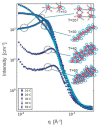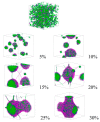Structures and Applications of Thermoresponsive Hydrogels and Nanocomposite-Hydrogels Based on Copolymers with Poly (Ethylene Glycol) and Poly (Lactide- Co-Glycolide) Blocks
- PMID: 31766313
- PMCID: PMC6955967
- DOI: 10.3390/bioengineering6040107
Structures and Applications of Thermoresponsive Hydrogels and Nanocomposite-Hydrogels Based on Copolymers with Poly (Ethylene Glycol) and Poly (Lactide- Co-Glycolide) Blocks
Abstract
Thermoresponsive hydrogels showing biocompatibility and degradability have been under intense investigation for biomedical applications, especially hydrogels composed of hydrophilic poly(ethylene glycol) (PEG) and hydrophobic poly(lactic acid-co-glycolic acid) (PLGA) as first-line materials. Even though various aspects such as gelation behavior, degradation behavior, drug-release behavior, and composition effect have been studied for 20 years since the first report of these hydrogels, there are still many outputs on parameters affecting their gelation, structure, and application. In this review, the current trends of research on linear block copolymers composed of PEG and PLGA during the last 5 years (2014-2019) are summarized. In detail, this review stresses newly found parameters affecting thermoresponsive gelation, findings from structural analysis by simulation, small-angle neutron scattering (SANS), etc., progress in biomedical applications including drug delivery systems and regeneration medicine, and nanocomposites composed of block copolymers with PEG and PLGA and nanomaterials (laponite).
Keywords: PEG; PLGA; block copolymer; degradation; drug delivery; laponite; nanocomposite; regeneration medicine; structural analysis; thermoresponsive hydrogel.
Conflict of interest statement
The author declares no conflict of interest.
Figures







References
-
- Jeong B., Bae Y.H., Kim S.W. Thermoreversible gelation of PEG-PLGA-PEG triblock copolymer aqueous solutions. Macromolecules. 1999;32:7064–7069. doi: 10.1021/ma9908999. - DOI
-
- Jeong B., Bae Y.H., Kim S.W. Biodegradable thermosensitive micelles of PEG-PLGA-PEG triblock copolymers. Colloid Surf. B Biointerfaces. 1999;16:185–193. doi: 10.1016/S0927-7765(99)00069-7. - DOI
Publication types
Grants and funding
LinkOut - more resources
Full Text Sources
Other Literature Sources

